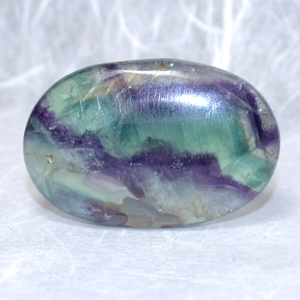Flourite is named for the Latin "fluo"-- to flow, because it is used as an additive to aid in proper flow for iron smelting. Additionally, the phenomenon "flourescence" takes it's name from this stone where strong flourescence can commonly be observed under UV light.
Excellent Specimens of flourite have beautiful, intense color banding in all shades of purple, mint green to teal, some pink and white. Strong color banding is a good way to identify flourite, but not all material is so fantastically banded. See below:This is more common.
Flourite is found commonly cut into beads, and for other ornamental purposes. It can be found cut as a gemstone for setting in jewelry, but it is a relatively soft stone, making this practice uncommon.
This gem does have a common place in gemstone healing, however. It is thought to strengthen one's power of concentration. It is also used to cleanse the aura, and it is applied directly to an ailing part of the body to relieve pain.
Different colors of flourite are thought to have more specific benefits, more information on this here: http://www.charmsoflight.com/fluorite-healing-properties.html



